Monday`s at typesofchicken.com are reserved for our weekly Pros and Cons articles concerning a particular chicken breed.
As we have said many times before, we write these articles based on our own opinions and experiences as well as research. There are exceptions in every breed, so if you have had a different experience with the breed in question, feel free to share it with us.
For this Monday, we decided to do an article about the Wyandotte chicken breed.
If you are interested in any other particular breed, check out the rest of our Pros & Cons articles.
Pros:
1. Extremely Active (a good thing)
Great foragers and extremely active chickens. Wyandotte chickens are famous for their ability to be energetic and playful.
They won’t let anything get in their way, and that can also be a pro as much as it can be a con.
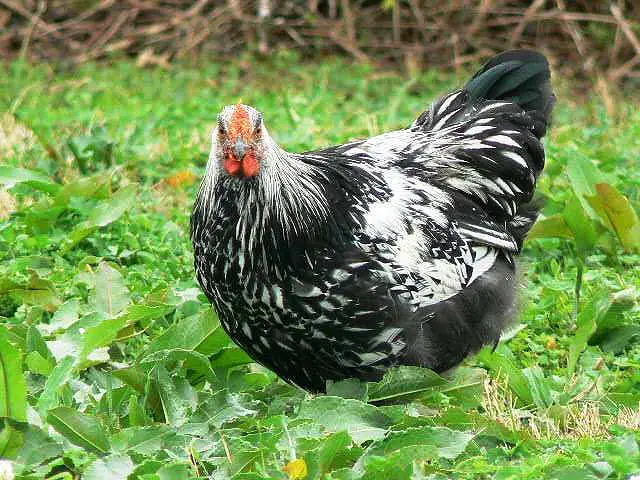
2. Are Wyandotte chickens Great Layers?
The Wyandotte chicken breed is capable of providing you with a large number of eggs.
Of course, you need to have the means to provide them with the nutritious materials needed in order for a hen to lay quality eggs, and you will be more than satisfied with the outcome.
Due to their size, Wyandotte chickens are able to lay large eggs.
The size of the eggs that this breed brings to the table should not be a concern to any chicken keeper.
3. What color do Wyandotte Chickens have?
The Wyandotte chickens are available in a huge variety of colors, and that makes them special to many chicken-keeping enthusiasts.
From red to silver-laced, the colors this chicken breed is available in can make them fit in any color scheme if you are into that kind of stuff.
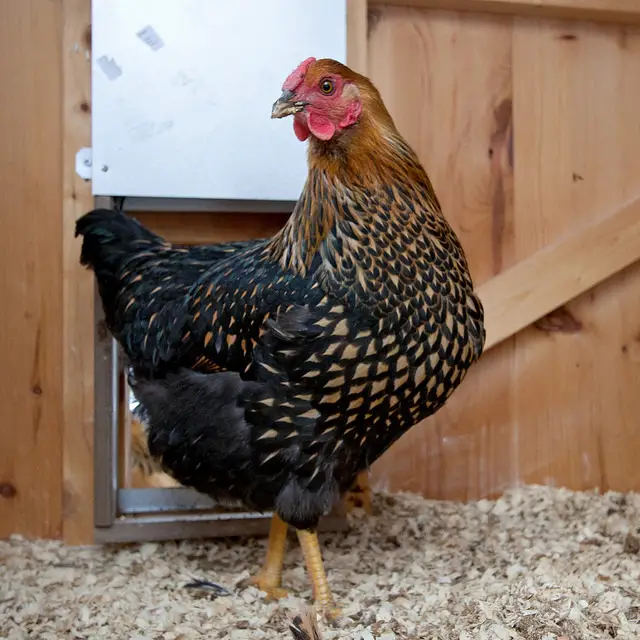
One of the favorite types among chicken keepers is the Golden-Laced Wyandotte chicken. They tend to be great as pets, so if you have kids, this breed will definitely be your best friend.
Also, Golden Laced Wyandotte chickens are a dual-purpose breed that can lay around 220 eggs per year and provide you with amazing chicken meat.
Golden Laced Wyandotte hens are really great mothers, they take care of their chicks a lot!
Cons:
1. Extremely Active (a bad thing)
This can be a bad thing because being extremely active means that they will also be flighty and can be bullies.
Due to their size being large, they will feel superior to other chickens and that will give them the freedom to bully them until the pecking order is formed.
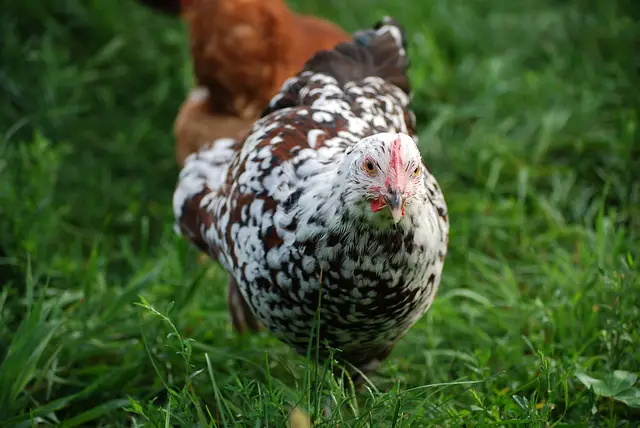
Some chicken keepers say that only their Wyandotte chickens disturbed the pecking order.
2. Not Too Friendly
Although extremely beautiful with the variety of colors they are available in, the Wyandotte chickens do not want to pet.
They can get aggressive towards other animals and children, but we believe that with the proper care, even Wyandotte chickens can be taught to be friendly.
The best thing to do is get them as young as possible and give your best to train them properly.
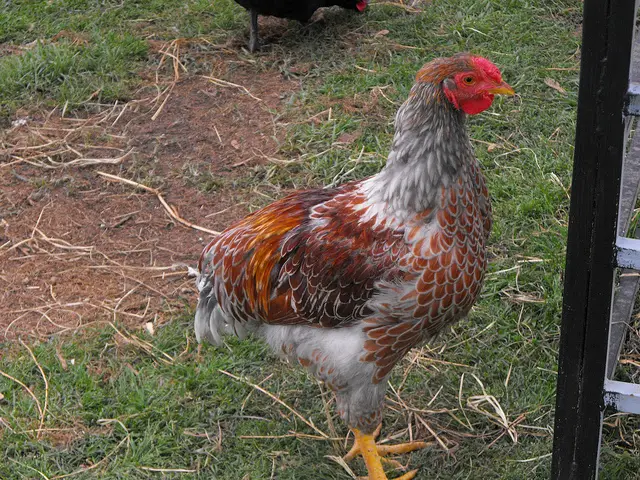
3. Not Good In Handling Heat
The Wyandotte chickens are not very good in handling the heat so they will most likely need some special attention during the hot summer days.
It is important that they receive proper ventilation and have fresh water during the day.
Also, some shade in your run can help them have easier summers and you get more quality eggs from them.
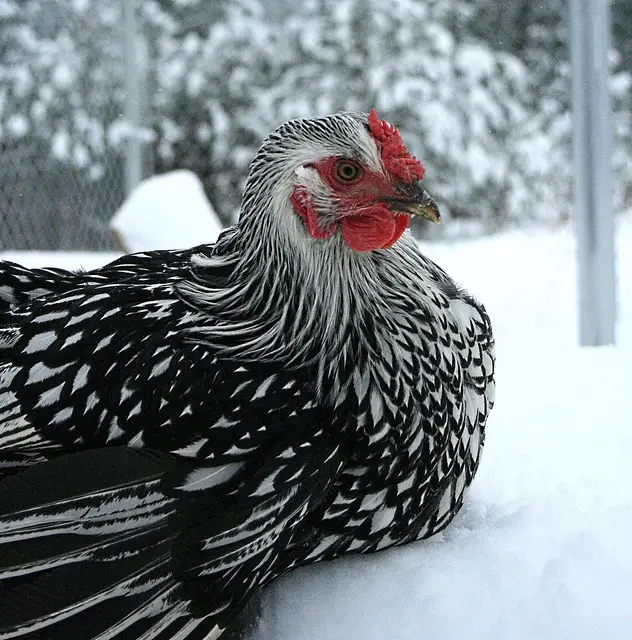
FAQ
What type of comb do Wyandotte chickens have?
Based on our research, Wyandotte chickens have a rose comb. But you can occasionally meet some male/female Wyandotte’s with a straight comb. This is a well-known secret among Wyandotte Chicken Breeders.
What does this mean?
Well, some lines of Wyandottes are not pure for the Rose Comb gene, breeders do this on purpose, there is only one main reason some breeders do this, and its because pure Rose Comb birds(R/R) have a lower fertility rate than Heterozygous Rose Comb Males(R/r+) and there is the fact that the Rose Comb gene is one of the few completely dominant genes.
And what does this mean?
It means that you can’t tell apart a heterozygous rose comb rooster(R/r+) from a Homozygous Rose Comb rooster(R/R) so some single comb wyandottes are to be expected…
Are Wyandotte roosters aggressive?
Wyandotte roosters are a popular choice for backyard chicken keepers due to their attractive appearance and versatile characteristics.
However, the question of whether Wyandotte roosters are aggressive can lead to mixed opinions among chicken enthusiasts.
By analyzing various experiences shared by fellow chicken keepers, we can gain insight into the behavior of Wyandotte roosters and the factors that contribute to their disposition.
Aggressive Behavior and Variation: Some backyard chicken keepers have reported instances of aggression among their Wyandotte roosters.
For instance, hatchery-bred Wyandotte roosters like Stan have been known to exhibit aggressive tendencies. Stan’s propensity to flog humans and hens alike showcased his aggressive nature.
Additionally, certain Wyandotte hens can also display aggressive behavior, particularly when they are broody. The experience of an aggressive SLW (Silver Laced Wyandotte) rooster named Chloe further emphasizes the variability in behavior. Chloe’s unwavering aggression, regardless of attempted interventions, posed a challenge for the flock dynamics and well-being of the hens.
Source of Aggression: Aggression in Wyandotte roosters seems to stem from various sources, including genetics and upbringing. Reports indicate that roosters obtained from hatcheries might be more prone to aggression compared to those from breeder stock.
While some chicken keepers have experienced aggressive roosters, others have had more positive interactions with gentle and well-behaved Wyandotte roosters. This suggests that genetic factors, early socialization, and breeding practices play crucial roles in shaping a rooster’s behavior.
Managing Aggression and Selecting Roosters: Dealing with aggressive Wyandotte roosters requires careful consideration. Recognizing signs of aggression and implementing appropriate interventions are essential to ensure the well-being of both roosters and hens.
Some keepers opt to rehome aggressive roosters to environments where their behavior can be better managed, while others prioritize breeding from reputable sources to acquire well-tempered roosters.
The experiences of backyard chicken keepers underscore the importance of selective breeding and sourcing roosters from breeders known for producing amicable Wyandotte chickens.
The behavior of Wyandotte roosters can vary widely, influenced by genetics, upbringing, and individual temperament.
While some backyard chicken keepers have encountered aggressive Wyandotte roosters that posed challenges to flock dynamics, others have enjoyed the companionship of well-behaved and friendly individuals.
Understanding the sources of aggression, implementing appropriate management techniques, and selecting roosters from reputable breeders are key considerations for creating a harmonious and enjoyable backyard chicken keeping experience with Wyandotte roosters.
Can Wyandotte chickens be feather sexed?
Have you got your own Wyandotte chicks and want to know if they are male or female?
If they are like 5-10 days old, it’s so hard to know the difference. We would suggest waiting for like 4-6 weeks and looking for these indications:
MALE
- Sturdy legs
- Medium-sized pinkish comb
- Wattles starting to hang down in a curve
- Stumpy, curved tail
- Downy back with a thin line of stub feathers down the center
- Poor feathering on side of the neck, crop, and flanks
- Bare wing bows, showing wing covert quills
FEMALE
- Fine legs
- Small yellow comb
- Wattles practically non-existent
- Long pointy tail
- More advanced feathering along the center of the back
- Well advanced feathering on side of the neck, crop, and flanks
- Wing bows covered with small feathers
What is your experience with this breed?
Share them with us in the comment section below or via e-mail at support@typesofchicken.com
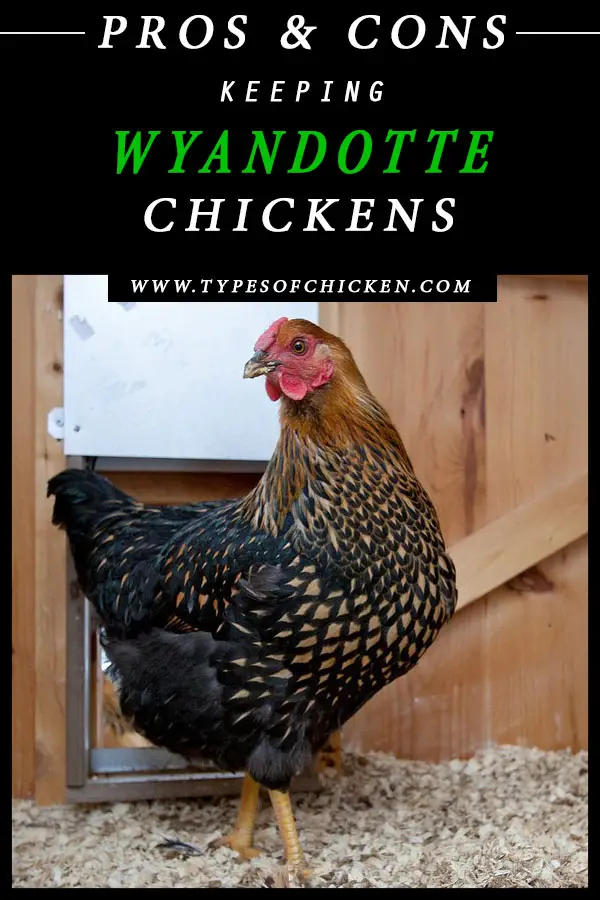
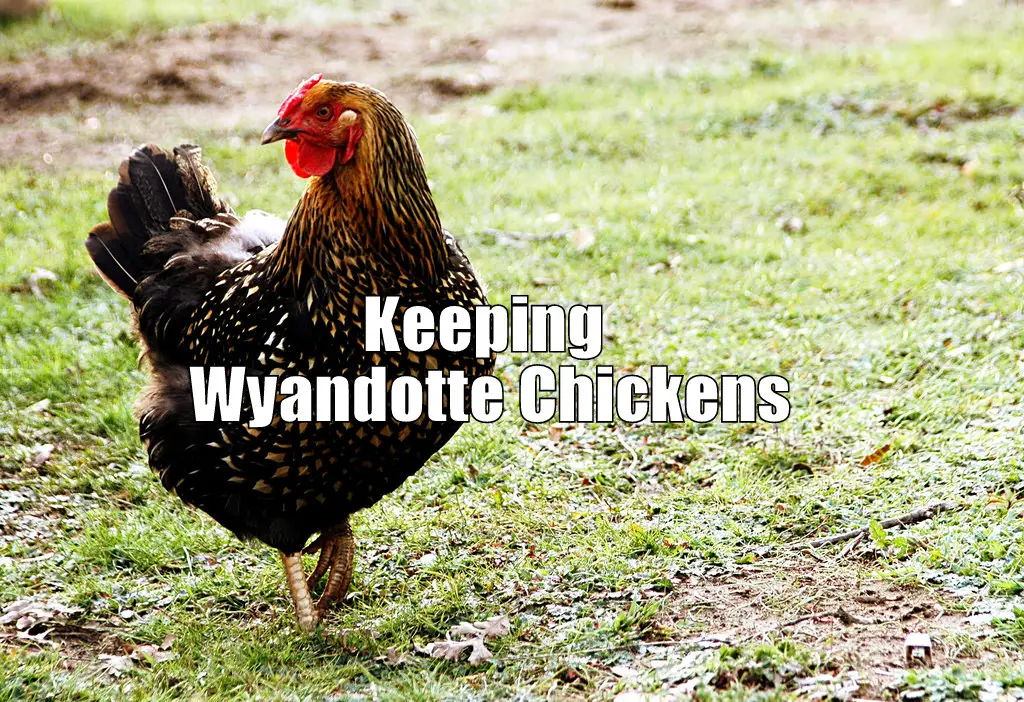

Active and not friendly? You’ve gotta be kidding! In my experience (many years raising and 10+ showing poultry) Wyandottes are good foragers but not at all flighty. I have never had problems with cooping in winter, unlike several other breeds, these birds seem to get along with others of all sizes and breeds. They do not tend to feather pull or be aggressive to other birds as long as they have the minimum recommended space requirements. Wyandottes are very easily handled, make good pets, and are my top breed recommendation for new chicken owners.
Oh, You mentioned – not every case the same, ofcourse 😉 I got 7 chicken breeds 140 in total (still just 3 months young). And when I sit with them while they run free around, This is the only breed which comes to me, sit on my leg or friendly come real close. They are not scared at all. And not aggressive for now. My favourite breed.
We just adopted our neighbor’s lovely silver laced wyandotte because it refused to stay in their yard with their rooster. We have named her Lady Cluck. We noticed her in our yard starting last summer and we got so used to seeing her we did not realize that she adopted us and had taken up residence in our bushes, As the weather has been getting colder now in October we decided to ask them what plans they had for her for winter protection. They gasped and were astonished because they thought that she had been killed by a predator months ago! Needless to say they were very happy to give her to us now that we are attached to her. She is very friendly and smart seeing that she stayed safe from predators in the woods. We love her as our pet! She now has a warm safe home with us and will never have to worry about coyotes or eagles or where her meals come from. We would love to try to train her on a harness if possible so that she can safely go on walks in the woods with us. <3
Oh how cute! If you find out how to train her would you email me. louy51@yahoo.com. Thank you. Lou Young
Our silver laced Wyandotte is the hen that is always getting bullied by the other hens in our flock. She is also the most submissive to us of all our hens, so I don’t find your negative comments to be true at all.
I have a golden laced Wyandotte hen and rooster. Our hen is the top of the pecking order but is not aggressive or mean to the others, but she doesn’t put up with any nonsense either(I call her the no nonsense hen). She does lay eggs almost every day except when she was molting. My rooster, Maximus is a real hoot! Ive had them all since only days old, and have handled them regularly. Max comes to me whenever I call him, he always greets me when I get home from work, and even demands some lap time drinking water out of his own cup when letting them out to forage. He is not aggressive at all towards me, my husband, or our dog. However he is Leary of strangers and keeps his distance. I have really enjoyed them.
My gold lace is aggressive and biting combs on my more docile lavender orphington. It’s happened twice. I separated her to another coop, but in the summer she can’t be stuck in a coop because it’s too hot – usually they free range during the day. What to do. They don’t get along and full grown birds. The Wyndotte will chase down the Lavender Orphington, jump her pulling feathers and bloody combs. The fights reek havoc in the coop too, squawking, nesting covers pulled down and feed/water bowls kicked over. Wyandotte beats her wings and acts like she wants to be leader. My Orphingtons are friendly, social and big which I think bothers the Wyndotte. There is plenty room in the coop – 5×6 coop with a 9 ft run. For now the Wyndotte is in a separate coop. Any other advice?
It sounds like you have a problem with aggression between your Gold Lace Wyandotte and your Lavender Orpington chickens. Separating the two birds is a good temporary solution, but it’s not a long-term solution because they will eventually need to be together again.
Here are some suggestions for how to address this problem:
Reintroduction: Try reintroducing the two birds in a neutral environment, such as a large outdoor space or an enclosed area that neither bird is familiar with. This may help to reduce territorial behavior.
Redecorating the coop: You could rearrange the coop to create a more open layout with plenty of hiding places and perches. This will allow the chickens to avoid each other if necessary.
Increasing the size of the run: If the run is too small, the chickens may become more aggressive because they are feeling cramped. Consider expanding the run or creating a larger outdoor space for the birds to roam.
Adding more birds: Adding more birds to the flock can sometimes help to reduce aggression because the aggressive bird may become less focused on the victim bird. However, be careful to introduce new birds slowly and carefully to avoid causing more problems.
Using deterrents: You could try using physical deterrents such as chicken saddles or spray-on products that make the victim bird less attractive to the aggressor. These products are designed to make the feathers less attractive to pecking.
Separating the Wyandotte: If none of the above solutions work, you may need to permanently separate the Wyandotte from the rest of the flock. This is not an ideal solution, but it may be necessary if the aggression continues.
Remember, every flock is different, and what works for one group of chickens may not work for another. Be patient, observe your chickens closely, and be prepared to try different solutions until you find one that works for your birds.